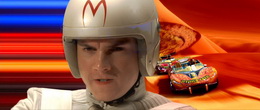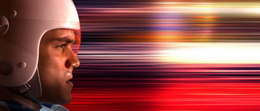This is part of Eric’s live coverage of the Siggraph 2008 Festival in Los Angeles as it appears on DigitalContentProducer’s LiveBlog. Check it out for the full details and all of Eric’s articles.
 A lot of focus this year at Siggraph has been on stereoscopic 3D and its emergence as a new language of filmmaking. If 3D is a new way of making movies, then the vast visual effects team that worked on Speed Racer discovered a reinvention of 2D filmmaking.
A lot of focus this year at Siggraph has been on stereoscopic 3D and its emergence as a new language of filmmaking. If 3D is a new way of making movies, then the vast visual effects team that worked on Speed Racer discovered a reinvention of 2D filmmaking.
Visual Effects Supervisor John Gaeta calls the style pioneered on Speed Racer many things. Among them: “virtual cinematography,” “photo-anime,” and “2 1/2 D” layering. When he and Dan Glass first started working on the project, it was a liberating experience to force themselves to let go of the need for any kind of photorealistic element. This quality is something ingrained into any visual-effects artist worth his salt from the get go. Letting go of that instinct is like asking a cat to ignore a mouse.
The production panel this morning on Speed Racer was about a 1/3 as full as yesterday’s effects talk on Cloverfield and Iron Man. More than anything, that speaks to Warner Bros.’ failure as a studio to promote such a pioneering film. Getting a close-up look behind the way images were manipulated and layered by a visual-effects team that spanned 14 different effects houses and completed 2,000 effects shots in six months was a real treat.
In their quest to create a live-action interpretation of Japanese anime, Gaeta and Glass first looked at the title sequence of the original animated TV show. The animation may be crude but its budget limitations often forced the ’60s series to get creative with things like wacked-out perspectives and surrealistic backgrounds. Mimicking that creativity was something the supervisors encouraged for all of the houses who worked on the project including BUF, Digital Domain, Sony Pictures Imageworks, and Industrial Light & Magic, who all had representatives on the panel.
 Rather than depicting reality, the team embarked on a journey to create a new form of layered unreality. By shooting 360-degree panoramas of locations all around the world and bringing them back to life as layer upon layer of greenscreen backgrounds, the visual-effects artists acted as virtual cinematographers, simulating all kinds of impossible camera angles and settings. The location bubbles-as they called them-would be subject to all kinds of manipulation such as sphere distortion, pulling focus, lightning-fast zooms, and lens changing.
Rather than depicting reality, the team embarked on a journey to create a new form of layered unreality. By shooting 360-degree panoramas of locations all around the world and bringing them back to life as layer upon layer of greenscreen backgrounds, the visual-effects artists acted as virtual cinematographers, simulating all kinds of impossible camera angles and settings. The location bubbles-as they called them-would be subject to all kinds of manipulation such as sphere distortion, pulling focus, lightning-fast zooms, and lens changing.
Digital Domain’s Kim Libreri talked about how his team was responsible for creating completely CGI cars that were virtually lit with a liquid look that would reflect the car’s surroundings as it sped down the track. This image-based lighting technology contributed to the film’s hyper-real look.
Simon Vanesse from BUF elaborated on the challenges of creating 2D images for things like smoke, which is an element that most effects crews can spend months trying to make look as 3D as possible. Vanesse says that BUF’s creations moved like 3D images, but were created specifically to look flat.
Industrial Light & Magic’s John Knoll, who supervised 38 shots in one sequence (the introduction of Racer X), was also on the panel and spoke about how the challenge of staying away from photorealism was way out of his comfort zone. He imagined the frame was an illustration and asked himself how he would color it in. After going with a severely saturated color scheme, he got the comment back from Gaeta and Glass: not saturated enough. At that point, rather than making just some of the colors extreme, Knoll moved the overall saturation average up way higher.
Kevin Mack from Sony Image Pictureworks was responsible for three sequences, all of them racing moments. He was happy, he says that all the people who had worked on the movie before he came on board had already figured out the universe they were creating in, even if Gaeta and Glass didn’t want to admit it yet. “When you’re doing something that’s never been done, you don’t exactly know you’re there yet,” he says.
As production design and cinematography become more and more the realm of the visual-effects teams, virtual cinematography will become more common. In Speed Racer, Gaeta says, the artists were using “expressive effects” the same way an anime artist will heighten emotion, prioritizing that aspect over a simple approximation of reality.
It’s a shame that the film’s lackluster box office performance will almost guarantee no 3D transfer in the near future because, as Gaeta told me after the session, he originally envisioned the movie as the ultimate View-Master experience. To have layers of flat images in stereoscopic 3D would truly be 2 1/2 D.








{ 4 comments }
I’ve never seen a movie like it, and that’s why it was one of my most memorable experiences at the cinema this whole year. I can’t wait to get it on DVD, because this was visually phenomenal, and really is the next step forward for cinematography. I would have fucking loved it if this was in 3D, too, that would make me call up my whole family to watch this! XD
I’ve never seen a movie like it, and that’s why it was one of my most memorable experiences at the cinema this whole year. I can’t wait to get it on DVD, because this was visually phenomenal, and really is the next step forward for cinematography. I would have fucking loved it if this was in 3D, too, that would make me call up my whole family to watch this! XD
Moeez-
We “Speed racer” fans will have our day. Just you wait…
Moeez-
We “Speed racer” fans will have our day. Just you wait…
Comments on this entry are closed.